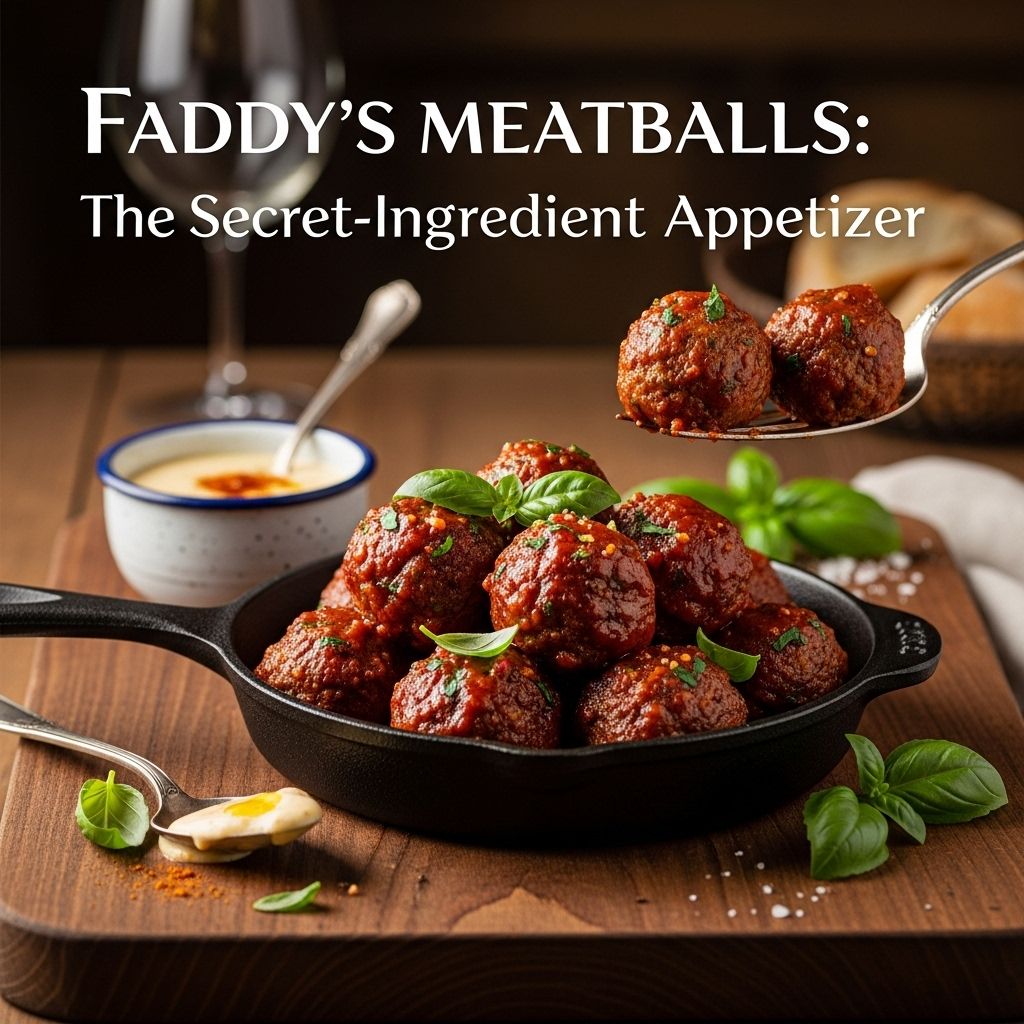Faddy’s Meatballs: The Secret-Ingredient Appetizer
Discover the beloved family recipe with stuffing mix and port wine sauce

There are certain recipes that transcend generations, becoming more than just food—they become treasured family traditions that carry memories, love, and legacy. Faddy’s Meatballs represent exactly this kind of culinary heirloom, a recipe so beloved that even professional chefs in the family can’t compete with its popularity. These aren’t just ordinary cocktail meatballs; they’re the appetizer that guests request year after year, the dish that disappears first at every gathering, and the recipe that has people literally drinking the leftover sauce straight from the pot.
What makes these meatballs truly special isn’t complexity or exotic ingredients—it’s the clever combination of a secret ingredient in the meatballs themselves and an absolutely addictive port wine sauce that elevates this humble appetizer to legendary status. Whether you’re planning a holiday celebration, hosting a game day party, or simply looking for a crowd-pleasing dish that can simmer away in a slow cooker while you entertain, Faddy’s Meatballs deliver every single time.
The Story Behind Faddy’s Meatballs
Every great recipe has a story, and Faddy’s Meatballs are no exception. The name “Faddy” originated from a toddler’s earnest attempt to say “Grandma,” and the endearing mispronunciation became the family’s affectionate name for a beloved great-grandmother. While memories of Faddy herself may have faded with time, her meatball recipe has ensured that her legacy lives on in the most delicious way possible.
These cocktail meatballs have become the absolute staple at family holiday gatherings and New Year’s Day celebrations, where they compete successfully with college football for attention. The recipe has been passed down through generations, with each family cook adding their own touches while preserving the essential elements that make these meatballs so irresistible. Even culinary professionals in the family have tried introducing new, sophisticated appetizers to the menu, only to find that guests still clamor for Faddy’s Meatballs above all else.
This speaks volumes about what truly makes food memorable. It’s not always about culinary technique or trendy ingredients—sometimes it’s about that perfect combination of flavors that creates pure comfort and satisfaction. Faddy’s Meatballs achieve this through simplicity executed brilliantly, proving that the best recipes are often those handed down with love rather than learned in culinary school.
The Secret Ingredient That Changes Everything
At first glance, these meatballs might seem fairly standard—ground beef, onions, salt, and pepper. But there’s one ingredient that transforms these from ordinary to extraordinary: Pepperidge Farm Herb Seasoned Classic Stuffing mix. This is the secret weapon that packs tremendous flavor into the meatballs without requiring a lengthy list of individual herbs and spices.
The stuffing mix serves multiple purposes in this recipe. First, it acts as a binder, helping to hold the meatballs together during cooking. Second, and more importantly, it infuses the meat with a complex blend of herbs and seasonings—sage, thyme, parsley, and other aromatics that are already perfectly balanced in the stuffing mix. This means you get restaurant-quality flavor with minimal effort and fewer ingredients to measure and mix.
The technique for incorporating the stuffing mix is crucial to the recipe’s success. Rather than simply mixing the dry stuffing into the ground beef, the recipe calls for soaking the stuffing mix in whole milk for about five minutes before combining it with the meat. This soaking step serves two important functions: it ensures the stuffing mix distributes evenly throughout the meat mixture, and it helps keep the meatballs incredibly moist and tender during baking. Nobody wants dry, crumbly meatballs, and this simple step prevents that common pitfall.
The Sauce That Steals the Show
While the meatballs themselves are delicious, it’s truly the sauce that elevates this recipe to legendary status. The sauce is so good that family members have been caught standing over the pot scooping it up or even drinking it after all the meatballs are gone. What creates this addictive quality? It’s the unexpected but brilliant combination of ketchup, port wine, sugar, vinegar, and Worcestershire sauce.
Each ingredient plays a specific role in creating the sauce’s complex flavor profile. The ketchup provides a tomato base with sweetness and body. The port wine adds depth, richness, and a subtle fruity note that makes the sauce sophisticated rather than one-dimensional. Sugar balances the acidity and brings out the other flavors. Vinegar cuts through the richness with brightness and tang. Worcestershire sauce contributes umami depth and savory complexity that makes the sauce utterly crave-worthy.
When these five ingredients simmer together, they create something far greater than the sum of their parts—a glossy, piquant sauce that’s simultaneously sweet, tangy, savory, and rich. The port wine is particularly important; family tradition suggests it’s the secret to the sauce’s irresistibility. While you could substitute another wine, the port’s fortified sweetness and deep flavor really do make a difference.
One important tip from those who’ve made this recipe many times: consider making a double batch of the sauce. Not only does it disappear quickly at parties, but leftover sauce is incredibly versatile. It can be frozen and later reheated to simmer with cooked kielbasa for another easy appetizer option, or used as a glaze for other proteins. The sauce keeps the giving even after the meatballs are gone.
Step-by-Step Preparation Guide
Making Faddy’s Meatballs is straightforward, but following the proper technique ensures perfect results every time. The process can be broken down into three main stages: preparing and baking the meatballs, making the sauce, and combining everything for serving.
Preparing the Meatballs
Start by preheating your oven to 350°F and lightly oiling a rimmed baking sheet. In a large bowl, combine one cup of Pepperidge Farm Herb Seasoned Classic Stuffing mix with one cup of whole milk. Let this mixture sit for approximately five minutes, allowing the stuffing to absorb the milk fully. You’ll notice the stuffing softening and expanding during this time.
Once the stuffing has absorbed the milk, add 2¼ pounds of ground beef, ½ teaspoon of kosher salt, ½ teaspoon of freshly ground black pepper, and two medium yellow onions that have been diced. Using your hands (the best tools for this job), mix everything together until the stuffing, onions, and seasonings are evenly distributed throughout the meat. Be careful not to overmix, as this can make the meatballs tough.
Now comes the shaping. Roll the meat mixture into balls approximately the size of ping-pong balls and arrange them on your prepared baking sheet. Try to make them as uniform as possible so they cook evenly. Bake for about 30 minutes, or until the meatballs are browned on the outside and cooked through. After baking, set them aside on paper towels to drain any excess fat while you prepare the sauce.
Creating the Port Wine Sauce
The sauce comes together quickly and easily. In a medium pot, combine one cup of ketchup, one cup of port wine, ½ cup of granulated sugar, ¼ cup of vinegar (white wine vinegar works beautifully), and ¼ cup of Worcestershire sauce. Whisk everything together and bring the mixture to a boil over medium-high heat.
Once boiling, reduce the heat to maintain a gentle simmer and cook for about 10 minutes. This simmering time allows the flavors to meld together and the sauce to thicken slightly. You’ll notice the sauce becoming glossy and developing a beautiful sheen as it reduces. The alcohol from the port wine cooks off during this process, leaving behind its rich flavor without the sharp alcohol taste.
Combining and Serving
At this point, you have two serving options. For immediate serving, you can simply pour the hot sauce over the meatballs in a serving dish, tossing gently to coat each meatball evenly, and serve right away. This method works well if you’re serving the meatballs shortly after preparation.
However, the preferred method—and the one that yields the best flavor—is to transfer both the meatballs and sauce to a large slow cooker and let them simmer together on low heat for 3 to 4 hours. While the meatballs can be served immediately after adding them to the slow cooker, they truly shine after simmering in that magnificent sauce for several hours. During this time, the meatballs absorb the sauce’s flavors, becoming even more tender and delicious, while also releasing their own savory juices into the sauce, making it even richer.
Perfect Occasions for Faddy’s Meatballs
One of the greatest advantages of this recipe is its versatility for different occasions. These meatballs work beautifully for virtually any gathering where you need a crowd-pleasing appetizer. Holiday celebrations are perhaps their most traditional setting—Christmas Eve, New Year’s Day, Thanksgiving—these meatballs have become synonymous with festive gatherings in many families.
They’re also perfect for game day parties. The slow cooker keeps them warm throughout the event, and guests can help themselves throughout the game without you having to interrupt the action to replenish appetizers. The combination of hearty meatballs and flavorful sauce pairs excellently with cold beer and the excitement of watching sports.
Potlucks and family reunions are another ideal venue for Faddy’s Meatballs. They transport well in the slow cooker, stay warm for hours, and are universally appealing to both children and adults. Plus, they’re easy to eat with just a toothpick or small fork, making them perfect finger food for casual gatherings.
Even casual dinner parties benefit from having these meatballs as an appetizer. You can prepare them ahead of time, let them simmer while you finish other dishes or spend time with guests, and they’ll be ready whenever you want to serve them. The slow cooker does all the work while you focus on hosting.
Tips for Success and Variations
While Faddy’s Meatballs are fairly foolproof, a few tips can help ensure perfect results. Don’t skip the milk-soaking step for the stuffing mix—this is crucial for even distribution and maintaining moisture in the meatballs. If you’re short on time, you might be tempted to skip this, but those five minutes make a real difference in the final texture.
Use good quality port wine for the sauce. Since it’s a primary flavor component, using a port you’d actually enjoy drinking will result in a better-tasting sauce. You don’t need to use an expensive vintage port, but avoid cooking wines that contain added salt and preservatives.
Make the sauce in advance if you’re preparing for a party. The sauce can be made a day or two ahead and refrigerated, then reheated when you’re ready to combine it with the meatballs. Some would argue the sauce actually improves after sitting, as the flavors continue to develop.
For variations, consider the meat blend. While the original recipe calls for all ground beef, a mixture of beef and pork (perhaps 1½ pounds beef and ¾ pound pork) creates an even more tender, flavorful meatball. Some cooks also add a small amount of ground Italian sausage to the mix for extra seasoning.
If you want to make the recipe slightly healthier without sacrificing flavor, you can bake the meatballs on a wire rack set over the baking sheet, allowing even more fat to drain away. You can also use ground turkey in place of beef, though you may want to add an extra tablespoon of olive oil to the mixture to compensate for turkey’s lower fat content.
Storage and Reheating Instructions
Faddy’s Meatballs actually taste even better the next day, making them perfect for advance preparation. To store leftovers, allow the meatballs and sauce to cool completely, then transfer to an airtight container and refrigerate for up to four days. The meatballs will continue to absorb the sauce flavors as they sit, becoming even more delicious.
For reheating, the slow cooker method works beautifully—simply add the meatballs and sauce to the slow cooker and warm on low for 1-2 hours. Alternatively, you can reheat in a covered pot on the stovetop over medium-low heat, stirring occasionally, until heated through.
These meatballs also freeze exceptionally well. Freeze them in the sauce in freezer-safe containers or bags for up to three months. Thaw overnight in the refrigerator before reheating. This makes them perfect for meal prep or for always having a crowd-pleasing appetizer ready in your freezer for unexpected entertaining needs.
Why This Recipe Endures
In an age of complex recipes with lengthy ingredient lists and complicated techniques, Faddy’s Meatballs remind us that sometimes the best dishes are those that balance simplicity with clever flavor-building. The secret stuffing mix ingredient is a brilliant shortcut that doesn’t sacrifice quality. The port wine sauce is unique enough to be memorable while still appealing to a wide range of palates.
But beyond the practical aspects, this recipe endures because it creates connections. It’s the dish that brings families together, that guests request by name, that creates new memories while honoring old ones. When a culinary professional admits that despite all their training and experience, their family still prefers Faddy’s Meatballs to anything else they can make, that speaks to the power of food to transcend technique and touch hearts.
These meatballs represent the best of home cooking: accessible ingredients, straightforward methods, and flavors that somehow manage to be both comforting and exciting. They prove that you don’t need exotic ingredients or complicated procedures to create food that people will remember and request for years to come.
Frequently Asked Questions
Q: Can I use a different type of stuffing mix?
A: While Pepperidge Farm Herb Seasoned Classic Stuffing is specifically recommended and tested in this recipe, you could experiment with other herb-seasoned stuffing mixes. Avoid cornbread or plain varieties as they won’t provide the same herb flavor profile that makes these meatballs special.
Q: What can I substitute for port wine?
A: If you don’t have port wine, you could use a sweet red wine like Marsala or even a good quality grape juice mixed with a tablespoon of balsamic vinegar. However, the port wine really does contribute a distinctive flavor that makes the sauce special, so it’s worth seeking out if possible.
Q: How many meatballs does this recipe make?
A: This recipe yields approximately 40-50 cocktail-sized meatballs, depending on how large you roll them. The recipe serves about 15 people as an appetizer, assuming guests will eat 3-4 meatballs each along with other foods.
Q: Can I make these meatballs ahead of time?
A: Absolutely! You can bake the meatballs up to 2 days in advance and refrigerate them. You can also make the sauce ahead and refrigerate separately. When ready to serve, combine them in the slow cooker and heat through. The meatballs and sauce can also be frozen together for up to 3 months.
Q: Do I have to use a slow cooker?
A: No, the slow cooker is convenient but not essential. You can simmer the meatballs in the sauce in a large pot on the stovetop over low heat, or keep them warm in a chafing dish. The slow cooker is simply the easiest hands-off method for keeping them at the perfect serving temperature during a party.
Q: Why do I need to soak the stuffing mix in milk?
A: Soaking the stuffing mix in milk serves two important purposes: it allows the stuffing to soften and distribute more evenly throughout the meat mixture, and it adds moisture that helps keep the meatballs tender rather than dry. This simple step makes a noticeable difference in the final texture.
Q: Can I make a larger batch?
A: Yes, this recipe doubles or even triples easily. Many families who make these for large gatherings routinely double the recipe. Just make sure you have a large enough slow cooker (or use two) to accommodate all the meatballs and sauce. A 6-quart slow cooker works well for a double batch.
Read full bio of Sneha Tete












